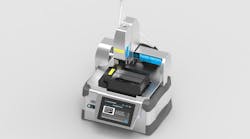At the Pacific Design & Manufacturing Show, Dolomite unveils its commercially available Fluidic Factory 3D printer for sealed microfluidic devices. The printer utilizes a cyclic olefin copolymer (COC) from TOPAS Advanced Polymers to produce a variety of microfluidic demonstration parts. It is running continually at TOPAS’ Booth #662.
The Fluidic Factory ehnables rapid prototyping of fluidically-sealed devices such as chips, sensor cartridges, fluid manifolds, valves, connectors, and medical devices. It can be used with TOPAS 8007S-04, a standard injection-molding grade filament for high-performance medical and optical applications. TOPAS COC is recognized as the industry standard in microfluidics and diagnostics because of its clarity, purity, chemical resistance, and UV transparency, according to Timothy Kneale, president of TOPAS Advanced Polymers.
As the first commercially available 3D printer for fluidically-sealed devices, it offers rapid, easy, and reliable printing of microfluidic devices at an economical cost. The Fluidic Factory features intelligent software and innovative hardware which ensures reliable sealing of fluidic paths, allowing the creation of precise channel geometries and various features not possible using etching, embossing, molding, or machining techniques.
Users can choose a design from the selection in the Fluidic Factory's Design Library, or create and print their own unique device using most CAD software. With this complete design flexibility, the Fluidic Factory is ideal for a wide range of applications, including organ-on-a-chip, point-of-care diagnostics, drug development, education, chemical synthesis, and analytical and biomedical assays.
With 92% clarity and mold detail of TOPAS COC, well counts are maximized, flow channels can be incorporated, and analyses are optimized. Due to its ultra-high purity, TOPAS COC has lower leachables and extractables than competing materials, resulting in the most reliable and repeatable results. The inert nature of the material prevents interference with reactions and analyses. Other important features include the best available UV transparency of any plastic and low autofluorescence.
“We gave careful consideration to a range of materials for our breakthrough 3D fluidics printer and selected TOPAS COC due to the unique properties and benefits it offers over other polymers, making it ideal for microfluidics in biology and medical environments,” said Dr. Omar Jina, Dolomite’s Chief Commercial Officer. “It is the polymer most frequently requested by biologists and has won acceptance in the microfluidics industry.”

